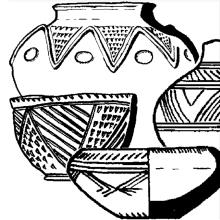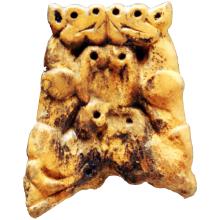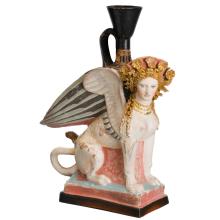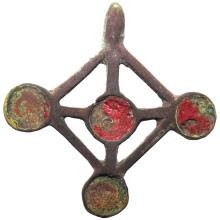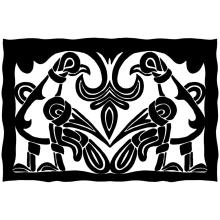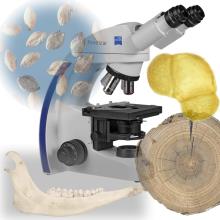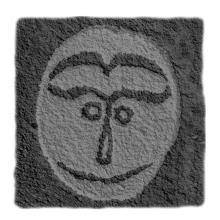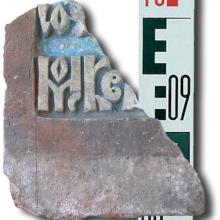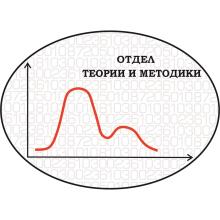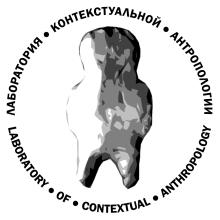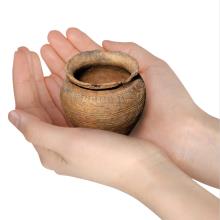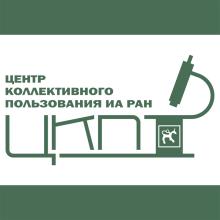The study of a pendant with an enamel insert found in a cultural layer of the beginning of the 13th century in Novgorod, was conducted by the research team including scientists from the Institute of Archeology of the Russian Academy of Sciences, Kazan (Volga Region) Federal University, the National Research Centre “Kurchatov Institute” and the Federal Research Centre “Crystallography and Photonics” of the RAS. A comprehensive study of the artefact using natural science methods showed that the precious quadrifoil pendant was made by Russian or Byzantine craftsmen. It is worth noting that it was the melted smalt of Roman or early Byzantine mosaics dating back to the 1st millennium AD that was used to make the enamel. The results of the study were presented by the authors at the scientific conference “Archaeological research: new materials and interpretations”.

Pendant. 1 - photo, 2 - drawing (by A.V. Vasilieva)
“It is for the first time that ancient Russian gold jewellery with enamel decoration was studied comprehensively, using high-precision methods, which provided us an opportunity to study the structural elements of the pendant and the ways of their fastening, as well as to identify the manufacturing technology of the housing and determine the composition of the metal and enamel. The obtained data allowed us to assume that the pendant had been made in Rus either by Greek craftsmen or by Russian jewellers using a Byzantine-made enamel insert,” said Irina Zaitseva, one of the authors of the study, senior researcher at the Department of Medieval Archeology of the Institute of Archeology of the Russian Academy of Sciences.
The studies were carried out at the Centres for Collective Use (CCU) of the Institute of Archeology of the Russian Academy of Sciences, the Federal Research Centre “Crystallography and Photonics” of the Russian Academy of Sciences and the National Research Centre “Kurchatov Institute” - State Research Institute of Chemical Reagents and Highly Pure Chemical Substances.
In summer 2018, an expedition of the Institute of Archeology of the Russian Academy of Sciences, headed by Corresponding Member of the Russian Academy of Sciences Pyotr Gaidukov, started excavations in Veliky Novgorod. In a small excavation site (about 140 sq. m.) on Znamenskaya Street, archaeologists found a section of ancient Pavlov Street and the remains of four medieval homesteads. A lot of artefacts were collected there. They were found in the cultural layer more than 5 meters deep, the lower part of which dates back to the first quarter of the 11th century, and the upper part to the end of the 15th to the beginning of the 16th centuries. The artefacts indicate the high social status of the inhabitants: seals of Novgorod princes and service people, Byzantine trade seals, jewellery, items of personal piety and other objects made of metals, bone, amber, glass, stone and clay.

Pendant
A gold pendant with enamel insert was discovered in the remains of a residential house made of thick pine logs. According to dendrochronological analysis, the house was built in the early 1210s. It was the last house built on this site before the long desolation of this part of the city, which was probably caused by catastrophic epidemics, famine years in Novgorod in the first third of the 13th century, and a general decline in economic life that came after the Mongols conquered the central and southern regions of medieval Rus.
Pendant in the shape of a quadrifoil (a decorative element in which a square is combined with a flower with symmetrical petals overlapping each other) consists of two plates, front and back, connected by soldering, and an eyelet. The front surface of the pendant is decorated with a convex image of flowers connected by a stem. A hole 10 mm in diameter was cut in the centre of the plate, with a round enamel insert placed in it. The outer edge of the plate and the area around the hole are framed by two rows of frequent small cavities, creating the impression of belts made of filigree “bead” wire.
The quadrifoil motif was very popular in various fields of medieval European art such as architecture, book miniatures, and applied arts. Also, it was used in ancient Russian jewellery. Thus, gold links of ornamental pendants and pendants from South Russian treasures were made in the form of quadrifoil. What's more, gilded bronze pendants of this form with enamel coating are known.

3D pendant model with its separated parts
The Novgorod pendant stands out from this series: it is made of gold, and the pattern on the front plate is completely embossed on the matrix. This is the uniqueness of the object: embossing was almost never used to decorate ancient Russian gold jewellery with filigree enamel. Usually it was used only to create trays for enamel, and the margins of gold pendants, as a rule, remained smooth.
“The gold pendant from Novgorod is a true piece of art. The high professionalism and excellent taste of the craftsmen are visible both in the manufacture of the housing made of high-grade gold and in the enamel insert. It has no analogies either in Byzantine materials or in Old Russian ones. Most likely, it was part of a rich ceremonial dress,” noted Irina Zaitseva.
In order to study the internal structure of the pendant, to determine the manufacturing technology and composition of the metal and enamel, the scientists conducted a comprehensive analytical study using modern natural science methods.

Pendant details. Pic. 1.2 - gap between the plates, pick. 3 - soldering uncertainties,
pic. 4 - embossed plate (front side), pic. 5 - eye, 6, 7 - central insert
To study the internal structure of the pendant, a neutron tomography survey was carried out. Unlike x-rays, neutrons penetrate deep into a gold item, allowing us to see its internal structure. Based on the results of the survey, a three-dimensional model of the object was constructed, which made it possible to virtually “disassemble” the product into structural elements and establish the ways of their fastening. A tomographic study showed that in the central part of the inner cavity of the pendant, under the enamel insert, there is a small accumulation of loose substance. The scientists decided not to open the pendant as the filling does not contain solid particles, such as the content of encolpion, but seems to be clogged with soil.
To determine what metal the pendant was made of, the scientists used scanning electron microscopy dispersive X-ray spectrometry (SEM/EDS) and laser ablation inductively coupled plasma mass spectrometry (LA-ICP-MS). The study revealed that all the metal parts of the pendant are made of high concentration gold, and the percentage of gold in different parts of the item is almost the same. This indicates that all the metal parts of the pendant were created at the same time. The composition of micro-impurities suggests that the gold was obtained from a alluvial deposit, and no other metals were added to it during the manufacture of the pendant.

Photo of an enamel insert with the designation of regions of the spectrum.
Research areas of the composition of enamels by SEM/EDS (squares) and LA-ICP-MS (circles)
The central decoration of the pendant is an insert made using the filigree enamel technique, the partitions are made of gold plates soldered to the housing. In the centre of the round medallion there is an image of a shamrock filled with red enamel. It is surrounded by white enamel, which creates a contrasting background. The shamrock, together with the background, covers a ring of blue enamel, with a triangle made of turquoise enamel under the shamrock. The entire image is framed by an outer ring made of red enamel.
The experts studied the composition of the enamel using scanning electron microscopy dispersive X-ray spectrometry (SEM/EDS) and laser ablation inductively coupled plasma mass spectrometry (LA-ICP-MS).
The study showed that the white, blue and turquoise enamels of the medallion have the same chemical composition of the base soda glass and differ only in dyes. The composition of the enamels is very close to the chemical composition of Roman and early Byzantine mosaics. For example, the white enamel of the quadrifoil is almost completely similar to the glass of the mosaic tiles from the Basilica di San Severo in Ravenna, and the cobalt pigment in the blue enamel includes a set of elements typical of the Roman handicraft tradition: cobalt, manganese, copper and iron.

Optical photograph of the enamel medallion
The composition of red enamel contains a different set of basic elements and is close to Byzantine sodium-lead glass, which originates in the Roman craft tradition and lasts until the end of the Byzantine era. For example, glass Byzantine rings of the 14th century with a similar composition were found during the excavations in Bolgar in the area of central market.
“Judging by the composition, the enamels of the Novgorod pendant are not made of medieval glass, but of Roman mosaics. It is known that this technology was commonly used in medieval enamel production in Western Europe, for example, in Limoges enamels. The process included collecting mosaics in ruined buildings, cleaning them of surface dirt and grinding into a fine powder. Then water was being added, and the resulting mixture was being applied to the metal surface, dried and fired in special furnaces at a temperature that melted the powder but not the metal,” explained Olga Rumyantseva, researcher at the Department of Archeology of the Great Migration Period and the Early Middle Ages of the IA RAS.
The determination of the exact place and time of production of the enamels proves to be difficult, according to Svetlana Valiulina, associate professor at the Department of Archaeology and General History of Kazan Federal University due to the long-term invariability of technological and stylistic traditions of production. These traditions hadn’t changed from Roman times to the end of the Byzantine era. The second difficulty is related to the fact that there was a practice of reusing enamels: the design and fastening of the inserts on the panels and icon settings were made so that it was possible to remove the enamel decoration from an old, possibly unfit for use, housing and transfer it to a new one.
 Element distribution maps obtained by X-ray fluorescence analysis (30-micron ray beam) of the enamel medallion surface
Element distribution maps obtained by X-ray fluorescence analysis (30-micron ray beam) of the enamel medallion surface
“It could be assumed that the enamel insert on the Novgorod quadrifoil was also used a second time, given its not quite even location on the gold housing, while everything else in its design is perfect. But the enamel medallion with a trefoil in the centre forms a harmonious ensemble with the decorated gold housing. In its decoration the trefoils and their derivatives, the five-petaled palmettes, play the leading role. Three variants of the origin of the pendant and the insert may be suggested: the insert as well as the entire piece of art was created either in Byzantium, or by Greek craftsmen in one of the Russian towns, or the enamel insert could have been made in one of the Byzantine workshops and brought to Rus. But in any case an imported, probably Byzantine, enamel was used,” said Svetlana Valiulina, associate professor of the Department of Archaeology and General History at Kazan Federal University.
“This work is a vivid example of interdisciplinary research. Using a number of natural science methods we obtain new historical, art history data,” emphasized Ekaterina Yatsishina, Deputy Director for Research, Head of the Laboratory of Natural Science Methods in the Humanities of the National Research Center “Kurchatov Institute”.



